Eve of War
In 1940, Florida was the smallest state in the Deep South; its population of 1.9 million inhabitants lagged behind South Carolina and Arkansas. Jacksonville was the state’s largest city (173,000), followed by Miami (172,000) and Tampa (108,000). Perhaps more revealingly, future Sunbelt cities such as Boca Raton (723), Sarasota (11,000), and Orlando (37,000) were modest-sized cities. Some of the state’s fastest-growing cities (Cape Coral and Coral Springs, Weston and North Port) were not yet born.
Florida in 1940 stood precariously between its rock-hard rural, southern traditions, and a swelling wave of northern influences, especially in the fast-growing Gulf and Atlantic resort cities. Technology was pushing change. Air conditioning could be found in fancy movie theatres, while radio was creating a national consumer culture. Newspaper editors and commentators noted a profound attitudinal and latitudinal split roughly along an imaginary line from Cedar Key to Ocala to Daytona Beach. Writers from Florida: A Guide to the Southernmost State (1939) stated, “Politically and socially, Florida has its own North and South but its northern area is strictly southern and its southern area is strictly northern.”
Florida was already becoming the least southern state. Sunshine State residents were whiter, older, wealthier, more religiously, ethnically and racially diverse and more likely to reside in cities than their counterparts in Alabama, Georgia, or North Carolina. Florida’s economy rested upon an uneasy tripod of agriculture, tourism, and extractive industries. In at least one area, however, Florida remained rigidly southern. Segregation was the law and custom of the land. Frightening levels of interracial violence continued through the decade of the 1930s.
The documents and images below reveal just a sliver of life in Florida on the eve of WWII.
Images
-
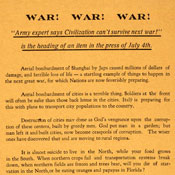
- War! war! war! "Army expert says civilization can't survive next war!"
-
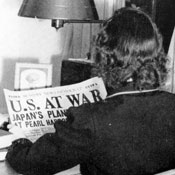
- An FSCW student reading newspaper about Pearl Harbor Attack
-
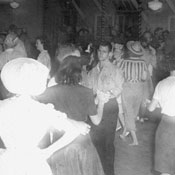
- Dance at the NYA's Camp Roosevelt
-
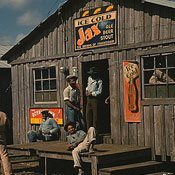
- Living quarters and "juke joint" for migratory workers
-
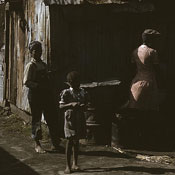
- Negro migratory workers by a shack
-

- Condemned housing occupied by negro migratory workers
-
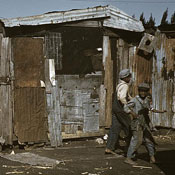
- Shacks of Negro migratory workers
-
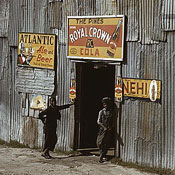
- Negro migratory workers by a "juke joint"
Documents
- "Runways get hot as CAA fliers start growing wings"
- St. Petersburg Times article about CAA training at Albert Whitted airport, July 1, 1940.
- Courtesy of the Florida State Archives
- Census Data 1940
- Florida 1940 Census data from the US Census Bureau, also available at: http://www.census.gov/prod/www/abs/decennial/1940.htm.
- Florida Then and Now: Comparison Data from 1940 to 2006
- Florida population data comparing 1940 to 2006, as synthesized by historian Gary R. Mormino.
- Courtesy of Gary R. Mormino, the Frank E. Duckwall Professor of Florida Studies
The Struggle for Voting Rights: A Series of Letters
A series of letters between Thurgood Marshall, E.L. Bryan, The Tampa Chapter of Sleeping Car Porters, and Norman Lacey regarding a lawsuit challenging the all-white primary for elections in Tampa. The series is not complete and does not reflect the ultimate outcome of the case. It does, however, reveal an interesting and somewhat tense dynamic between Thurgood Marshall and the Florida lawyers. The visual quality of the reproductions of Marshall’s letters is poor in some instances.
- Letter from Bryan & Bryan to Thurgood Marshall - July 26, 1941
- Courtesy of the Library of Congress
- Letter from Bryan & Bryan to Thurgood Marshall - August 04, 1941
- Courtesy of the Library of Congress
- Letter to Walter White about suit against Tampa Election Board - November 25, 1941
- Letter to Walter White from the Tampa Local of the Brotherhood of Sleeping Car Porters about status of suit against the Tampa Election Board for denying Negros the right to vote in the white primary.
- Courtesy of the Florida State Archives
- The Struggle for Voting Rights: Letter from Thurgood Marshall to Norman Lacey - December 16, 1941
- Courtesy of the Library of Congress
- The Struggle for Voting Rights: Letter from Bryan & Bryan to Thurgood Marshall - December 22, 1941
- Courtesy of the Library of Congress
- The Struggle for Voting Rights: Letter from Thurgood Marshall to Bryan & Bryan - December 24, 1941
- Courtesy of the Library of Congress
- The Struggle for Voting Rights: Letter from Thurgood Marshall to Norman Lacey - February 09, 1942
- Courtesy of the Library of Congress
